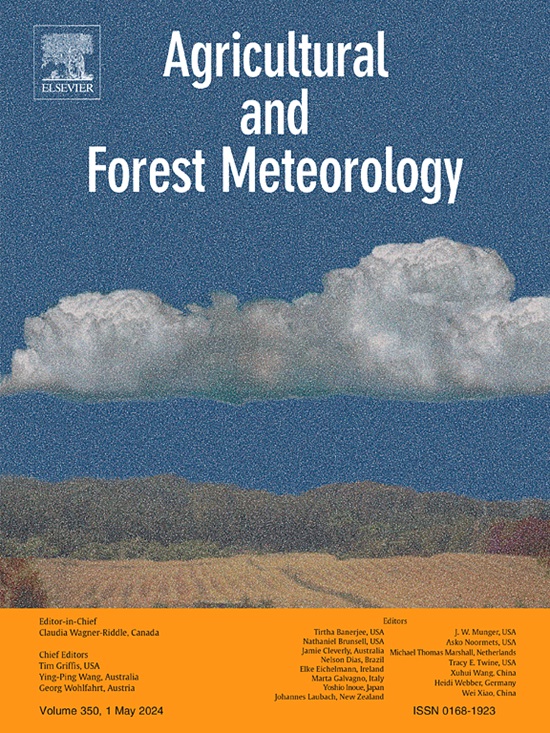针叶树在其冷区极限附近的年龄相关水分响应
IF 5.6
1区 农林科学
Q1 AGRONOMY
引用次数: 0
摘要
冷亚北极和亚高山森林的生长动态主要对温度敏感,但生长响应可能因区域而异或随树木个体发育而变化。系统地评估寒冷分布边缘树木生长的温度和湿度限制的空间、种间和人口变化,对于增强我们对这些生态系统在气候条件下如何演变的理解至关重要。为了解决这一差距,我们建立了一个由22棵树木年轮宽度年表组成的网络,这些年表来自两个地区(Fennoscandia, European Alps),三个物种(Pinus sylvestris, Pinus cembra,落叶松)和两个年龄组(45-100岁和>;150岁)。我们将每日气候生长相关性与基于过程的Vaganov-Shashkin生长模型结合起来,以确定物种和年龄组之间关键生长因子的差异。此外,我们还评估了树木年轮异常宽和窄与特定气候异常年份的一致性。尽管生长季节温度是主要的生长限制因子,但水分平衡对树木生长的季节性影响相当大,且在不同地区、树种、特别是年龄群之间存在系统差异。芬诺斯坎地幼树的生长对水分平衡负响应,窄环与湿润年一致。相比之下,在阿尔卑斯山地区,幼树的生长受到干旱的限制。阿尔卑斯地区落叶松林各树种和两个年龄群的老树对水分平衡的敏感性有限。基于树木年代学的气候生长响应模式与基于单个年轮形成层年龄年代学的气候生长响应的个体发生变化相似。我们的研究结果强调,在大规模的寒冷森林生态系统研究中,需要考虑到物种间和人口对气候敏感性的差异。本文章由计算机程序翻译,如有差异,请以英文原文为准。
Age-dependent moisture response of conifers near their cold range limit
Growth dynamics of cold subarctic and subalpine forests are primarily sensitive to temperature, but growth responses may vary across regions or shift over tree ontogeny. Systematic assessments of spatial, interspecific, and demographic variation in temperature and moisture limitation of tree growth at cold distribution margins are essential for enhancing our understanding of how these ecosystems will evolve under climate regimes. To address this gap, we built a network of 22 tree-ring width chronologies from cold forests covering two regions (Fennoscandia, European Alps), three species (Pinus sylvestris, Pinus cembra, Larix decidua), and two age cohorts (45–100 and >150 years). We combined daily climate-growth correlations with the process-based Vaganov-Shashkin growth model to identify differences in critical growth factors between species and age cohorts. In addition, we assessed the coincidence of unusually wide and narrow tree rings with years of specific climatic anomalies. Although growing season temperature was the dominant growth-limiting factor, seasonal effects of water balance on tree growth were considerably large and varied systematically between regions, species, and particularly age cohorts. The growth of young P. sylvestris in Fennoscandia responded negatively to water balance and narrow rings coincided with wet years. In contrast, the growth of young P. cembra in the Alps was drought-limited. Old trees of all species and both age cohorts of L. decidua in the Alps showed limited sensitivity to water balance. The patterns of climate-growth responses in cohort chronologies based on tree age at the year of coring were similar to ontogenetic shifts of climate-growth responses if chronologies were based on the cambial age of individual rings. Our results stress the need to account for interspecific and demographic differences in sensitivity to climate in large-scale studies of cold forest ecosystems.
求助全文
通过发布文献求助,成功后即可免费获取论文全文。
去求助
来源期刊
CiteScore
10.30
自引率
9.70%
发文量
415
审稿时长
69 days
期刊介绍:
Agricultural and Forest Meteorology is an international journal for the publication of original articles and reviews on the inter-relationship between meteorology, agriculture, forestry, and natural ecosystems. Emphasis is on basic and applied scientific research relevant to practical problems in the field of plant and soil sciences, ecology and biogeochemistry as affected by weather as well as climate variability and change. Theoretical models should be tested against experimental data. Articles must appeal to an international audience. Special issues devoted to single topics are also published.
Typical topics include canopy micrometeorology (e.g. canopy radiation transfer, turbulence near the ground, evapotranspiration, energy balance, fluxes of trace gases), micrometeorological instrumentation (e.g., sensors for trace gases, flux measurement instruments, radiation measurement techniques), aerobiology (e.g. the dispersion of pollen, spores, insects and pesticides), biometeorology (e.g. the effect of weather and climate on plant distribution, crop yield, water-use efficiency, and plant phenology), forest-fire/weather interactions, and feedbacks from vegetation to weather and the climate system.

 求助内容:
求助内容: 应助结果提醒方式:
应助结果提醒方式:


